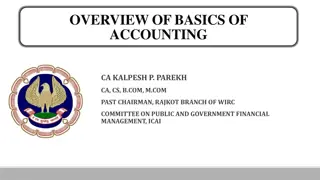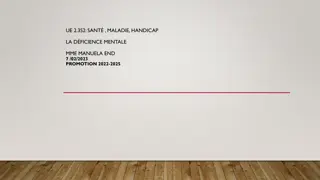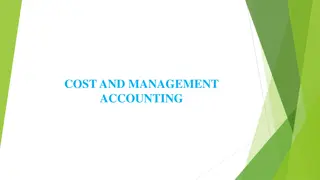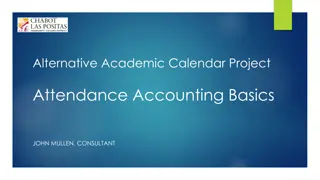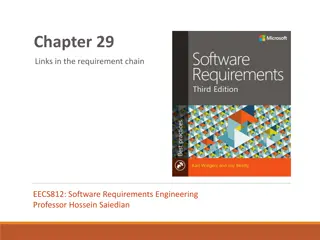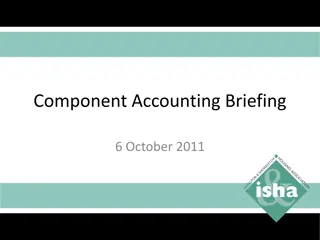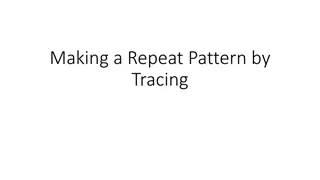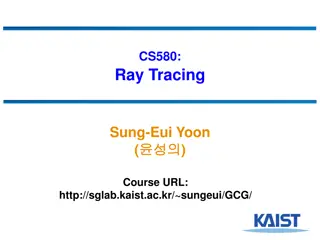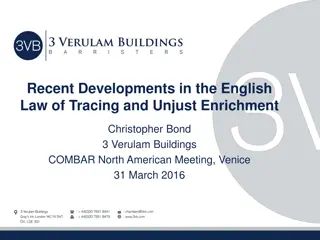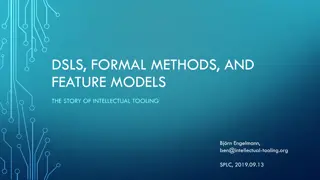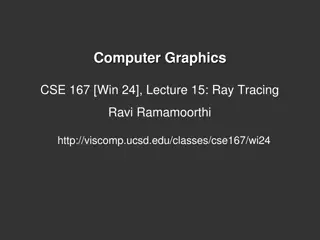Tracing Intellectual Origins in Accounting: A Journey of Thought Evolution
Tracing the intellectual origins in accounting reveals the roots and influences behind current theories and practices. This process involves connecting the dots across decades to understand the intellectual baggage inherited from the past. Different streams of thought in US accounting literature, starting with economists, have shaped the discipline. Key areas explored include decision usefulness, futurity in financial accounting, general price-level accounting evolution, and early academic contributions influencing accounting standards. The pathway to decision usefulness in management and financial accounting can be traced back to a pivotal chapter by economist John Maurice Clark in 1923, highlighting the importance of varying cost terminologies based on business needs.
Uploaded on Sep 21, 2024 | 3 Views
Download Presentation

Please find below an Image/Link to download the presentation.
The content on the website is provided AS IS for your information and personal use only. It may not be sold, licensed, or shared on other websites without obtaining consent from the author.If you encounter any issues during the download, it is possible that the publisher has removed the file from their server.
You are allowed to download the files provided on this website for personal or commercial use, subject to the condition that they are used lawfully. All files are the property of their respective owners.
The content on the website is provided AS IS for your information and personal use only. It may not be sold, licensed, or shared on other websites without obtaining consent from the author.
E N D
Presentation Transcript
Tracing Intellectual Origins in Accounting Stephen A. Zeff Rice University
Whittington (2023) writes, the ultimate motivation of scholarship is to obtain a clearer understanding of the present, by revealing the origins, assumptions and institutional framework which gave rise to our current theories and practices, i.e. to enable us to understand the intellectual baggage which we have inherited from the past. Tracing intellectual origins in accounting should be a staple in our literature, to demonstrate that there may be writings somewhere in the long line of our published research that may help us resolve some of today s conundrums. 2
Attempts at tracing intellectual origins are highly subjective interconnecting lines of thought across the decades, trying to infer cause and effect where possible. It is a matter of connecting the dots in the evolution of a stream of thought. I will discuss four streams of thought in the US accounting literature all, as it happens, begun by economists. And all eventually led to adoption by accounting standard setters, either in conceptual frameworks or in standards. 3
The origins of decision usefulness in both the management accounting and financial accounting literatures. The origin of today s emphasis on futurity in financial accounting. The thread in the evolution of the literature on general price-level accounting. The early academic writing which influenced the FASB to recognize the noncontrolling interest in goodwill in business combinations. 4
Decision usefulness Decision usefulness in both management accounting and financial accounting can be traced to a highly influential chapter in University of Chicago economist John Maurice Clark s 1923 book, Studies in the Economics ofOverhead Costs. 5
In Chapter IX: Different Costs for Different Purposes, Clark wrote: We may start with the general proposition that the terminology of costs is in a state of much confusion and that it is impossible to solve this confusion by discovering and adopting the one correct usage, because there is no one correct usage, usage being governed by the varying needs of varying business situations and problems. (p. 175) 6
He then proceeded to work through nine cases studies in the life-history of a factory, distinguishing between the differential costs involved in a particular decision and the costs which were constant, or unaffected, by the decision. 7
Johnson and Kaplan (1987, 135) have written, Textbooks in 1920s university accounting courses spoke of cost accounting strictly in terms of inventory costing for financial reporting purposes . As Taggart (1951) contended, this was little more than cost bookkeeping. 8
Clarks argument for tailoring costs to the decisions made by managers was almost entirely ignored until 1938, when William Vatter, a research assistant at the University of Chicago, wrote a 23-page modernizing chapter in a traditional cost accounting textbook. The chapter, entitled A Re-examination of Cost Accounting from the Managerial Viewpoint, was drawn almost entirely from Clark s Chapter IX. 9
After Vatter obtained his PhD in 1946 and became an accounting professor at Chicago, he proceeded to convey his appreciation of Clark s argument to his doctoral disciples: Charles Horngren George Sorter George Staubus David Green, Jr. 10
In 1950, Vatter completed a 500-page textbook manuscript, Managerial Accounting, infused with Clark s thinking, which his publisher persuaded him to put out as a preliminary edition. Due to high demand, it went through 18 printings. His book was said to have had enormous impact on the textbook literature it changed the field. In the 1950s and 1960s, other management accounting textbook authors, including Carl Devine, Robert Anthony and Gordon Shillinglaw, also began to bring Clark s thinking into their books. This was when cost accounting evolved into management accounting. 11
In 1962, Charles Horngren published Cost Accounting: A Managerial Emphasis, whose major theme, he said, was different costs for different purposes and was dedicated to Vatter. The book is now in its 17th edition. Beaver and Wolfson (2013, 435) wrote: Horngren s Cost Accounting was a master tome, and it fundamentally transformed management accounting, changing the field from a simple description of institutional practice relating to cost accumulation/ record keeping to an emphasis on uses of accounting data for decision-making purposes. Every textbook in the field since has followed this paradigm. 12
Gordon Shillinglaw, whose 1961 Cost Accounting textbook also followed Clark, wrote: More than forty years discussion has produced fairly substantial agreement as to what kinds of costs are relevant to short-run decisions. The route pointed out by J. M. Clark [in 1923] has since become a well- traveled road, and has led to near-unanimity of treatment in most textbooks in elementary and cost accounting. (1963, 73) 13
Clarks intellectual influence, transmitted via Vatter and his disciples, was not limited to management accounting. A leading committee of accounting theorists, in a major report written for the American Accounting Association (AAA), suggested that the strong user-oriented movement in the management accounting literature may have served as the stimulus for the initial acceptance of the decision-usefulness objective in external reporting (1977, 11) 14
In 1961, George Staubus became the first major advocate of decision usefulness in financial accounting in his book, A Theory of Accounting to Investors. He developed an accounting framework for informing investors of their prospects for cash receipts. Also in 1961, Charles Horngren and George Sorter, citing Clark, wrote in an article: Accounting is a tool for decision-making by managers, investors, and all interested parties. Usefulness for decision-making thus becomes the overriding criterion for judging existing financial reports. (1961, 86) 15
Hence, Staubus, Horngren and Sorter all students of Vatter were in the vanguard of the decision- usefulness movement in external reporting. In the 1960s and 1970s, the decision-usefulness approach emerged as an improvement over the procession of theories proposed from the 1920s into the 1960s in support of one or another true income a single valuation model, usually current cost accounting that were presumed to possess universal meaning to all users. 16
The first institutional support for decision usefulness came in 1966 with the report of an AAA committee, A Statement of Basic Accounting Theory (ASOBAT) The report disavowed recommending a single valuation base, and instead it focused on proposing the attributes of accounting information, as well as guidelines for communicating the information, so as to permit informed judgments and decisions by users of the information (1966, 1) The ASOBAT report comprehended both financial accounting and management accounting. 17
George Sorter was a member of the ASOBAT committee and was known for his unsurpassed powers of persuasion and articulation. He is believed to have played a considerable role in shaping the broad design of the committee s report. Staubus (1977, 25) has written that the ASOBAT committee s contribution to popularizing the decision- usefulness objective was immense. 18
In 1971, Sorter then became the full-time research director of the AICPA s Study Group on the Objectives of Financial Statements, chaired by Robert Trueblood. Through his proactive drafting, Sorter did much to steer the Study Group in the direction of decision usefulness. Its key recommendation was, The basic objective of financial statements is to provide information useful for making economic decisions. (1973, 13) 19
Sidney Davidson, who served on the Trueblood Study Group and was Sorter s colleague on the Chicago accounting faculty, when asked in an interview whether the ASOBAT report influenced the Study Group, replied as follows: George Sorter is never reluctant to offer his views. I m sure he was a strong influence on ASOBAT, where he was a member. And he carried over those same views to our Trueblood committee meetings. So I would be inclined to say that it wasn t so much we were influenced by ASOBAT as we were influenced by George Sorter. 20
The Trueblood Study Groups statement of objective was embraced by the FASB and, eventually, by all of the national and international standard setters in their conceptual frameworks. Hence, one observes that the infusion of differential costing in the management accounting literature and the installation of decision usefulness into the mainstream of financial reporting two fundamental shifts in accounting thought can to a considerable degree be traced, via Vatter and his doctoral disciples, to J. M. Clark s Chapter IX on different costs for different purposes in 1923. 21
Futurity in financial accounting Much of today s emphasis on futurity in financial accounting as reflected in conceptual frameworks statements of objectives which focus on enabling users to predict the amount, timing and uncertainty of future cash flows is traceable to a 1929 book by Stanford University economist John Canning. In his book, The Economics ofAccountancy, he followed Yale University economist Irving Fisher in proposing that assets be valued by reference to estimated future benefits. 22
Cannings book had a considerable impact on the accounting literature (Zeff 2000, 7-11) and was much appreciated by William Vatter, at Chicago, who evidently passed on this appreciation to his doctoral students. All four of Vatter s students Horngren, Sorter, Staubus and Green in their own writings in the early 1960s argued for asset valuation that focused on estimates of future benefits, citing Canning for support. 23
Sorter and Horngren argued for relevant costing and wrote (1962, 394), If a given cost will not influence either total future revenue or total future costs, it is not an asset. Green (1960) wrote along a similar line, coining the term cost obviation. Staubus wrote in the preface to his pioneering 1961 book aimed at informing investors of their prospects for future cash receipts, this essay would never have been started if Paton, Canning, and Vatter (in chronological order) had not made their stimulating contributions to accounting theory. (p. ix) 24
Even more consequential, George Sorter, as research director and principal draftsman for the Trueblood Study Group on the Objectives of Financial Statements from 1971 to 1973, did much to promote futurity in the recommendations for objectives in its final report. In a paper with Joshua Ronen, he was already on record as favoring futurity as a factor in composing a relevant accounting system. (1972) 25
Reed Parker, the lone financial analyst member of the Study Group, succeeded in persuading his accounting colleagues on the Group that investors are interested in future cash flows, not in one or another current valuation of assets. Parker recalled, in an interview, that as estimating future cash flows came to be discussed more and more in the Study Group sdeliberations, Sorter s drafting seemed to be coming more in my direction than I dreamed it would be. 26
The Study Groups recommendation was: An objective of financial statements is to provide information useful to investors and creditors for predicting, comparing, and evaluating potential cash flows to them in terms of amount, timing, and related uncertainty. (1973, 20) 27
The Study Groups recommended statement of objective on future cash flows, in this or modified wording, was subsequently adopted by the FASB in Concepts Statement 1 and eventually by accounting standard setters around the world in their own conceptual frameworks. Canning s 1929 book apparently stimulated a stream of thinking and writing that helps us understand why futurity occupies a central place in the objectives of financial reporting. 28
General price-level accounting Yale University economist Irving Fisher s writings and teaching seem to have propelled much of the evolution of the proposals in the US accounting literature on general price-level accounting (GPLA). Fisher was a pioneer of index numbers. 29
The first evidence was a short article in 1918, Should Accounts Reflect the Changing Value of the Dollar? by an unknown writer, Livingston Middleditch, Jr. Citing Fisher, the author proposed a series of index-number adjustments of current assets and liabilities, as well as of fixed assets and long-term liabilities, to reflect the decline in the purchasing power of the dollar. US inflation had been 100% between 1913 and 1920, and it was 17% in 1917. Oddly, Middleditch was never heard from again. 30
William Paton praised Middleditchs ingenious way of recognizing the impact of inflation in the accounts, and then, in a 1920 article, he began to realize that much of the run-up in the replacement cost of long-lived fixed assets in recent years was matched by inflation. Henry Sweeney, a PhD student at Columbia University, was influenced by Middleditch s and Paton s articles as well as by Fisher s writings. He undertook extensive research and published a widely praised 1936 book, StabilizedAccounting, to outline a complete methodology for incorporating inflation in the accounts. 31
Paton thereupon devoted a full chapter in his accounting textbooks to Sweeney s GPLA adjustments. In his solely authored Chapter 7 in his hugely influential 1940 monograph with A. C. Littleton, An Introduction to Corporate AccountingStandards, he urged that companies display such adjustments in supplementary statements. Ralph Coughenour Jones, a longtime accounting professor at Yale University, who had studied under Irving Fisher and briefly served in his Index Number Institute, wrote two major GPLA articles and two GPLA books between 1935 and the 1950s. 32
Together, Sweeneys and Joness advocacy, influenced directly and indirectly by the economist Irving Fisher, did much to bring GPLA into pronouncements issued in 1969 by the Accounting Principles Board and in 1974 and 1979 by the FASB, during the inflationary decade of the 1970s. 33
Consolidation goodwill in business combinations In 2007-08, the FASB and IASB issued standards on business combinations which called for full goodwill to be recognized as a requirement (US GAAP), or as an option (IFRS), when there was a noncontrolling interest in a combination. This issue had never previously been on any standard setter s agenda. Whence, and from whom, did it originate? 34
In a 1927 accounting textbook, in a chapter on the Consolidated Balance Sheet, Henry Rand Hatfield wrote: Inasmuch as in the consolidated balance sheet the full value of each of the assets is shown, although the holding company has only a fractional interest therein, it seems needlessly inconsistent in regard to the single asset goodwill to show only part of its value and to neglect entirely that portion representing the equity of the outstanding stockholders. (1927, 448) 35
Although Hatfield was a widely respected accounting professor at the University of California, his doctorate in 1897 was in economics and he had never taken a course in accounting or worked as an accountant. Maurice Moonitz, also at the University of California, then carried Hatfield s expression of puzzlement forward. He had studied under Hatfield, and Hatfield supervised Moonitz smaster s thesis on consolidated statements. 36
In 1943, Moonitz published an AAA monograph, The Entity Theory of Consolidated Statements, which argued that closely allied corporations should be treated as a distinct economic or accounting entity (p. vii), not as an extension of the parent company s interest. Goodwill, he argued, should be shown at its full amount, not just at the majority interest percentage. 37
In 1990-91, Moonitz brought his argument for full goodwill to the FASB. He served as one of the consultants to the FASB s staff that was drafting a discussion memorandum, Consolidation Policy and Procedures, issued in 1991, and he wrote several memos to the draftsmen. In 2005, when the FASB issued an exposure draft favoring the full goodwill approach, it actually cited and quotedthe sentence in Hatfield s 1927 book! 38
The influence of academic authors on the practice of accounting has been far less in America than in some other countries, such as Germany. Hence, the influence of Hatfield via Moonitz has been an interesting exception well worth noting. 39
Concluding remarks Traced four streams of accounting thought to their proximate origins Showed how to document the connections between originating authors and those who carried forward the lines of thought 40
Revealed that it was a financial analyst, not an accountant, serving on the Trueblood Study Group, who convincingly argued, with George Sorter s support, that investors are interested not in asset valuations but in estimating the enterprise s ability to generate future cash flows One hopes that the analysis in this paper makes a strong case for the benefits conferred by attempting to trace the intellectual origins of our contemporary beliefs and practice 41





